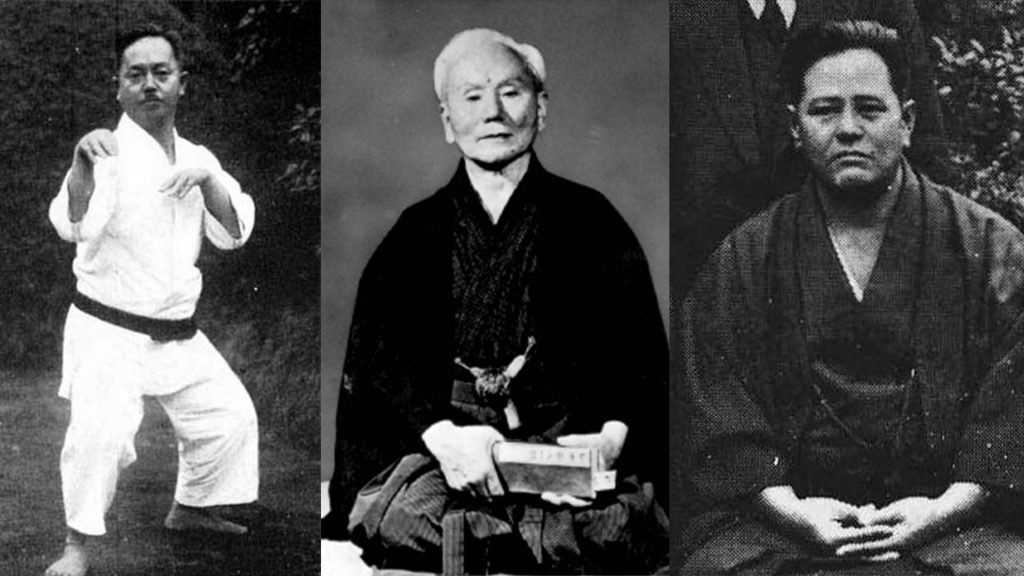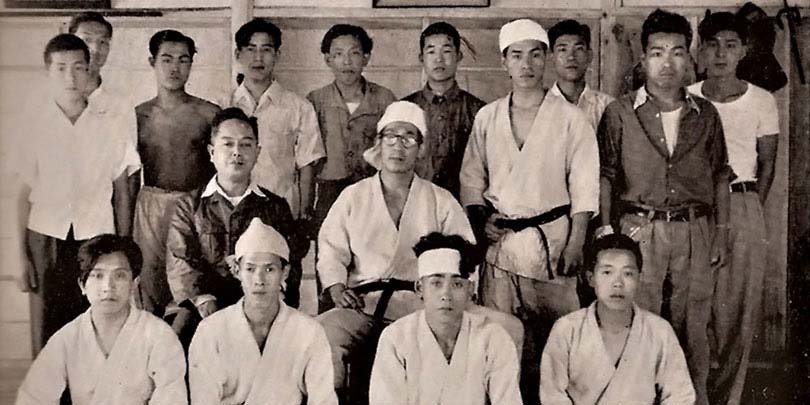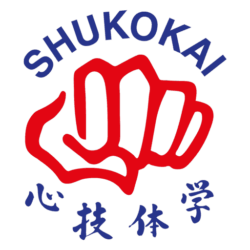
In the late 19th century, the Shuri-Te and Tomari-Te styles were united and became known as Shorin-Ryu. This happened as a result of natural mixing and not for political or social reasons.
Naha-Te became known as Goju under the leadership of Grandmaster Kanryo Higaonna. As a young man, Higaonna spent much time in the southern provinces of China. There he learned and modified the basic kata of the Goju system, Sanchin. The Shorin-Ryu system was brought to Japan in 1922 at the invitation of Crown Prince Hirohito by Gichin Funakoshi, a student of Itosu. Kenwa Mabuni, the founder of Shito-Ryu, followed him in 1930. Although Funakoshi and Mabuni were contemporaries and both students of Itosu, they went their separate ways: Funakoshi continued to study under Azato and Mabuni trained with Higaonna. Funakoshi stayed in Tokyo to train, Mabuni – out of consideration for his friend – travelled south and established his dojo in Osaka.
Mabuni’s decision to teach in Osaka was to have far-reaching consequences for the future. Funakoshi’s Shotokan, which was mainly practised in the capital Tokyo, was much more accessible to foreign soldiers after the war and could thus be exported more easily to other parts of the world. Even today, Mabuni’s Shito-Ryu has its greatest strength in the Kansei district of Japan, i.e. around Osaka, Kobe and Kyoto. On Okinawa, the absence of Mabuni and Funakoshi was the reason that Okinawa Karate was continued by Chojun Miyagi, who led the Goju school. From the three masters, Funakoshi, Mabuni and Miyagi, came all the major styles of Japanese karate, although other styles also developed on Okinawa.
Shukokai 修交会

Tani-ha Shito-Ryu was founded by one of Mabuni’s most advanced students, Chojiro Tani. Tani was the heir to his teacher’s kata scrolls and his appointed successor. Advanced instructors of Shukokai are or were Kawata, Yamada, Maeda, Satonobu, Takahara and Suzuki in Japan and Kimura in the USA and Europe.
Goju-Ryu 剛柔流
was founded by Chojun Miyagi (1888-1953). Goju was developed from the Naha-Te of Kanryo Higaonna and reflects a great influence of the southern Chinese internal arts. The style is represented in Japan by Gogan Yamaguchi and in Okinawa by the IOGKF of Morio Higaonna.
Shito-Ryu 糸東流
Founded by Kenwa Mabuni as a synthesis of Naha-Te and Shuri-Te, Shito-Ryu is named after the Chinese characters of Mabuni’s two teachers, Itosu and Higaonna. The Shito-Ryu system contains katas from all three original Okinawa systems, Shuri-Te, Naha-Te and Tomari-Te. There are a number of important branches of Shito-Ryu, the most important being Shukokai – Tani, Seikikai – Watanabe, Itosukai – Sakagami, Shitokai – Iwata, Renbukan – Sotokawa, Shito-Ryu – Kenei Mabuni and Hyashi-ha – S. Hyashi.
Shotokan 松濤館
Founded by Gichin Funakoshi, the Okinawa master who introduced karate to Japan in 1922. As a master of the Shuri Te system, he was familiar with the concept of Dō in karate, thereby ensuring its acceptance within the context of modern Japanese life. Shoto was Funakoshi’s pseudonym and in his later life older students called their dojo Shotokan (literally the house of Shoto or Funakoshi). The main branches of Shotokan are the Japan Karate Association (JKA), led by Nakayama until his death in 1993, the SKI of Kanazawa, the IAKF, founded and led by Nishiyama in the USA and Shotokai, founded by Shigeru Egami in 1950 to preserve unchanged the teachings of Funakoshi.
Kyokushin 極真
Founded by Maas Oyama. Born in Korea, Oyama was a student of Goju master Nei-Chu So and Shotokan founder Funakoshi.
Wado-ryu 和道流
Founded by Honorio Ohtsuka (1892-1982). Ohtsuka was a student of Gichin Funakoshi. Before his involvement in karate, Ohtsuka was an advanced exponent of ju-jutsu in the Kodokan (dojo of Kano Jigero, founder of judo). Wado Ryu contains many elements that reflect Ohtsuka’s early experiences of wrestling systems.
